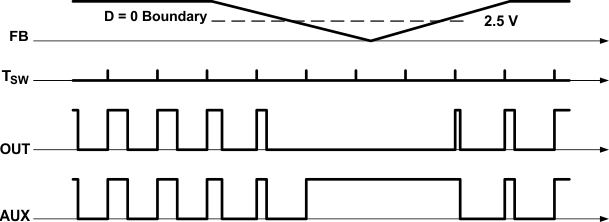SLUS829G August 2008 – February 2020 UCC2897A
PRODUCTION DATA.
- 1 Features
- 2 Applications
- 3 Description
- 4 Revision History
- 5 Device Options
- 6 Pin Configuration and Functions
- 7 Specifications
-
8 Detailed Description
- 8.1 Overview
- 8.2 Functional Block Diagram
- 8.3 Feature Description
- 8.4 Device Functional Modes
- 9 Application and Implementation
- 10Power Supply Recommendations
- 11Layout
- 12Device and Documentation Support
- 13Mechanical, Packaging, and Orderable Information
封装选项
机械数据 (封装 | 引脚)
散热焊盘机械数据 (封装 | 引脚)
- RGP|20
订购信息
8.3.5 Pulse Skipping
During output-load current-transients or light-load conditions most PWM controllers must be able to skip some number of PWM pulses. In an active-clamp topology where the clamp switch is driven complementary to the main switch, the skipping of pulses applies the clamp voltage across the transformer continuously. Since operating conditions might require skipping several switching-cycles on the main transistor, saturating the transformer is very likely if the AUX output remains on.
 Figure 22. Pulse Skipping Operation, P-Channel
Figure 22. Pulse Skipping Operation, P-Channel To overcome this problem, the UCC2897A family incorporates pulse skipping for both outputs in the controller. As shown in Figure 22, when a pulse is skipped at the main output (OUT) because the feedback signal demands zero duty-ratio, the corresponding output pulse on the AUX output is omitted as well. This operation prevents reverse saturation of the power transformer and preserves the clamp-capacitor voltage level during pulse-skipping operation.